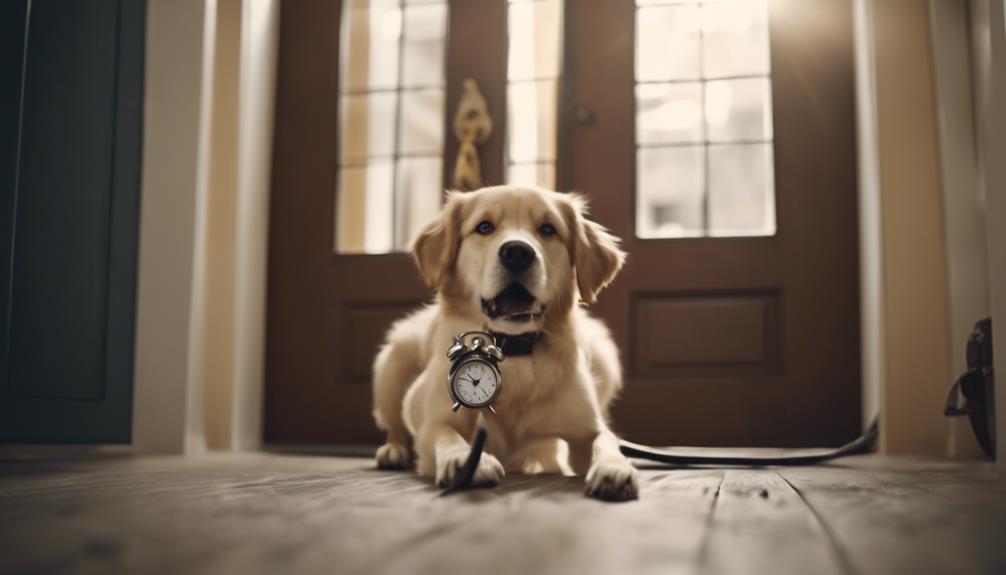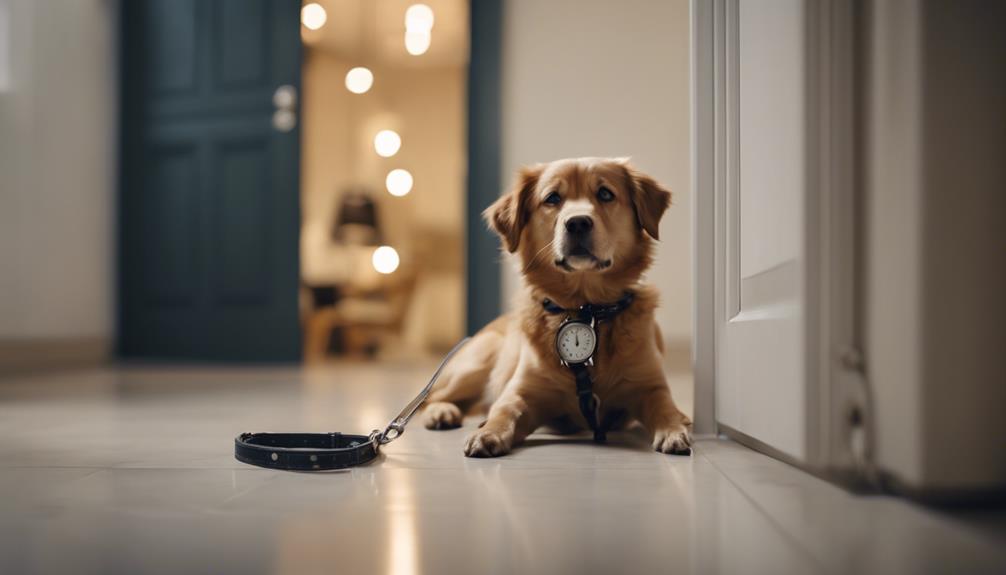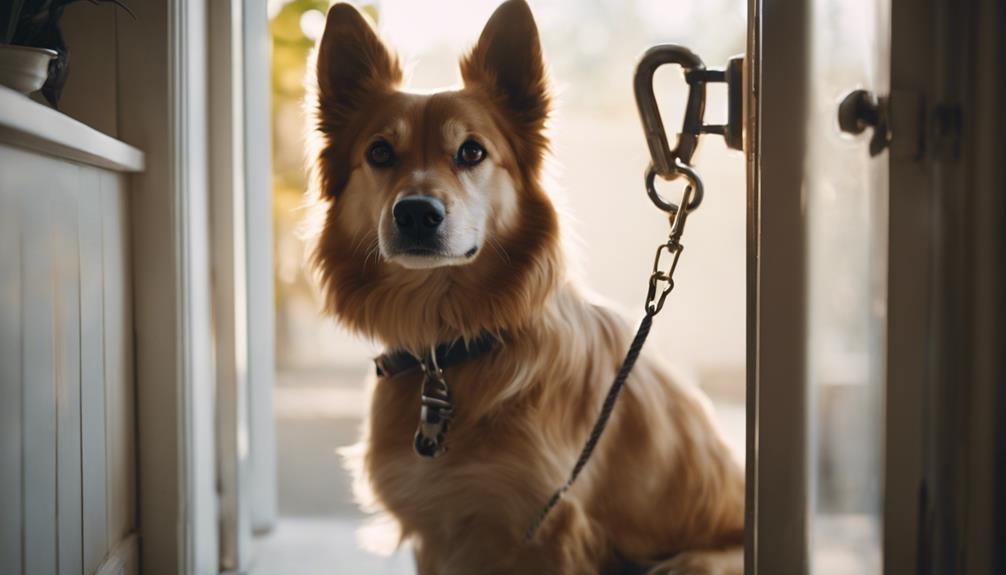The intricate ways in which dogs perceive time have long fascinated scientists and dog owners alike.
From their ability to anticipate routines to their uncanny sense of when it's time for a walk or a meal, dogs seem to have a grasp on time that goes beyond mere instinct.
However, the extent to which dogs truly experience time as we do remains a subject of ongoing inquiry.
As we explore the nuances of dogs' temporal cognition and the role that human influence plays in shaping it, a deeper understanding emerges of the interconnectedness between canines and their human companions.
Key Takeaways
- Dogs' sense of time is influenced by environmental cues and routines.
- Canines rely on human interactions and behaviors to understand time.
- Biological needs like hunger and bathroom breaks drive dogs' perception of time.
- Dogs learn cause and effect through routines and activities with humans.
Dogs' Perception of Time
Dogs demonstrate a unique perception of time, influenced by environmental cues and biological rhythms. Their understanding of time passing is intricately linked to stimuli such as the sun's position, hunger, thirst, and the moon's location.
Canines respond to circadian rhythms and external factors like light exposure, guided by a biological clock located in the hypothalamus. Pet owners play a significant role in aligning their pets' routines with human schedules, further shaping dogs' perception of time.
Environmental cues, such as meal times and daily patterns, are crucial for dogs to anticipate events. Through these cues and their innate biological rhythms, dogs navigate their daily lives, showcasing a remarkable ability to adapt and understand the passage of time.
Influence of Circadian Rhythms
The influence of circadian rhythms on dogs' perception of time is a key factor in understanding their daily routines and behaviors. Dogs, like humans, have internal biological clocks that regulate their sleep-wake cycles and other physiological processes.
Circadian rhythms synchronize with environmental cues such as light exposure, influencing dogs' activity levels throughout the day. Research suggests that dogs are sensitive to changes in light and darkness, which help them anticipate events like meal times or walks.
Understanding Daily Routines

Within the context of pet ownership and animal behavior studies, an insightful exploration of daily routines sheds light on the intricate relationship between environmental cues and behavioral patterns in canines.
Dogs thrive on predictable daily routines set by their owners. These routines, encompassing activities like feeding times, walks, and play sessions, help dogs understand and anticipate events throughout the day. By following established patterns, dogs associate specific cues with various activities, such as meal times or going outside.
Consistent routines provide dogs with a sense of security and structure, reinforcing their understanding of time within the context of their daily lives. Owners play a crucial role in shaping these routines, influencing their pets' perception of time and their behavior accordingly.
Impact of Biological Clock
Understanding the impact of the biological clock on canines provides valuable insights into how dogs regulate their daily rhythms and behaviors. The biological clock, located in the hypothalamus, plays a crucial role in governing various physiological processes and behaviors in dogs.
Here are three key points to consider:
- The biological clock influences dogs' sleep-wake cycles and hormone production, affecting their overall activity levels.
- It helps dogs anticipate regular events such as feeding times and walks, indicating the synchronization of internal processes with external cues.
- Disruptions to the biological clock, such as changes in routine or environment, can lead to behavioral changes or stress in dogs.
Association With Human Activities

Exploring dogs' interaction patterns with humans sheds light on their ability to synchronize daily activities with human routines. Dogs often mirror their owners' behaviors and habits, adapting to human schedules and cues. They recognize signals like putting on shoes for a walk or grabbing a leash for outdoor playtime.
Dogs eagerly participate in activities associated with their humans, indicating an understanding of routine and anticipation. This synchronization extends to meal times, play sessions, and even bedtime rituals. The bond between dogs and their owners strengthens as dogs learn to associate specific activities with human interactions, showcasing their adaptability and responsiveness to the cues provided by their human companions.
Learning Cause and Effect
Dogs demonstrate an aptitude for grasping cause and effect relationships through their interactions with humans and daily routines. This ability allows them to understand and predict outcomes based on specific actions and events.
Here are three ways in which dogs learn cause and effect:
- Dogs associate certain behaviors with specific outcomes, such as sitting leading to receiving treats.
- They learn from consequences, adjusting their behavior based on the results they experience.
- Dogs observe human actions and reactions, connecting them to subsequent events or rewards.
Role of Environmental Cues

When considering the influence of environmental cues on dogs' perception of time and daily activities, it becomes evident that these cues play a pivotal role in shaping their understanding and anticipation of events. Dogs rely heavily on external factors to navigate their daily routines and anticipate specific activities. Changes in light exposure, human behaviors, and regular routines all serve as cues for dogs to predict events such as meal times and walks. By observing and associating these cues with certain actions, dogs create a sense of time and structure in their daily lives. This adaptation to environmental cues showcases the close relationship between dogs and their surroundings.
| Environmental Cues | Influence on Dogs |
|---|---|
| Light Exposure | Predict Activities |
| Human Behaviors | Anticipate Events |
| Regular Routines | Create Structure |
Adaptation to Feeding Schedules
Adapting to feeding schedules, dogs demonstrate a remarkable ability to align their routines with both environmental cues and personal needs. Dogs' adaptation to feeding schedules is a fascinating display of their understanding and synchronization with daily routines.
Here are three key aspects highlighting their prowess in this area:
- Dogs exhibit behaviors signaling hunger or the need for bathroom breaks to communicate their needs effectively.
- They adjust their meal times based on routine and personal requirements, showcasing their ability to adapt to changing circumstances.
- Daily structures and choices provided by owners play a crucial role in reinforcing dogs' sense of time and meal schedule adherence.
Observing Human Behavior

By closely observing human behavior, dogs gain valuable insights into daily routines and social interactions. Dogs are keen observers and can pick up on subtle cues from humans to understand when certain activities are about to take place. Through this observation, they learn to anticipate events and adapt their behavior accordingly. Here is a table highlighting some key ways in which dogs observe and interpret human behavior:
| Observational Behavior | Description | Example |
|---|---|---|
| Body Language | Dogs pay attention to human gestures and postures. | Tail wagging indicating happiness. |
| Vocal Cues | They react to human voices and tones. | Responding to a command with excitement. |
| Routine Changes | Dogs notice variations in daily schedules. | Acting restless before the usual walk time. |
| Emotional Responses | Canines mirror human emotions. | Comforting a sad human by snuggling. |
Communication Through Behaviors
Dogs communicate through a range of behaviors that convey their needs, emotions, and responses to stimuli. These behaviors play a crucial role in their interactions with humans and other animals.
- Tail wagging: Indicates excitement, happiness, or agitation.
- Barking: Can signify various emotions such as fear, alertness, or playfulness.
- Body language: Postures like crouching, leaning, or jumping can convey different messages.
Understanding these behaviors is essential for pet owners to comprehend their dog's feelings and requirements effectively. By paying attention to these cues, individuals can strengthen their bond with their canine companions and ensure a harmonious relationship based on clear communication.
Conclusion
In conclusion, dogs' perception of time is intricately linked to their biological rhythms, environmental cues, and interactions with humans. By understanding how dogs interpret daily routines, events, and cues, we gain insights into their rudimentary sense of time.
Through observing human behavior and adapting to feeding schedules, dogs navigate their world and form emotional connections. This complex interplay enhances our understanding of dogs' cognitive abilities and strengthens the human-canine bond.




